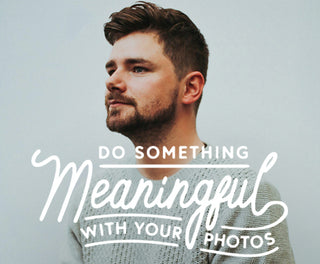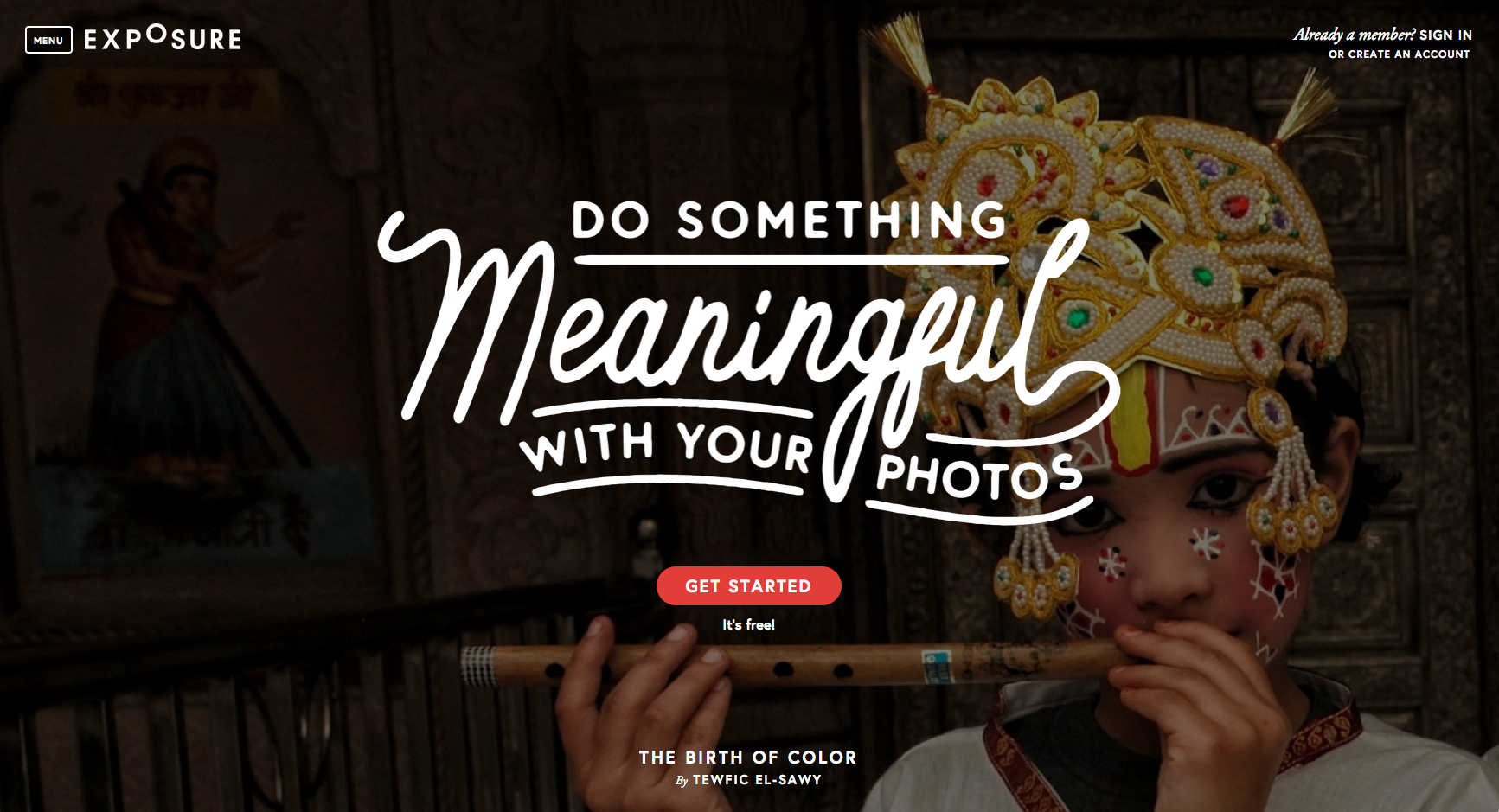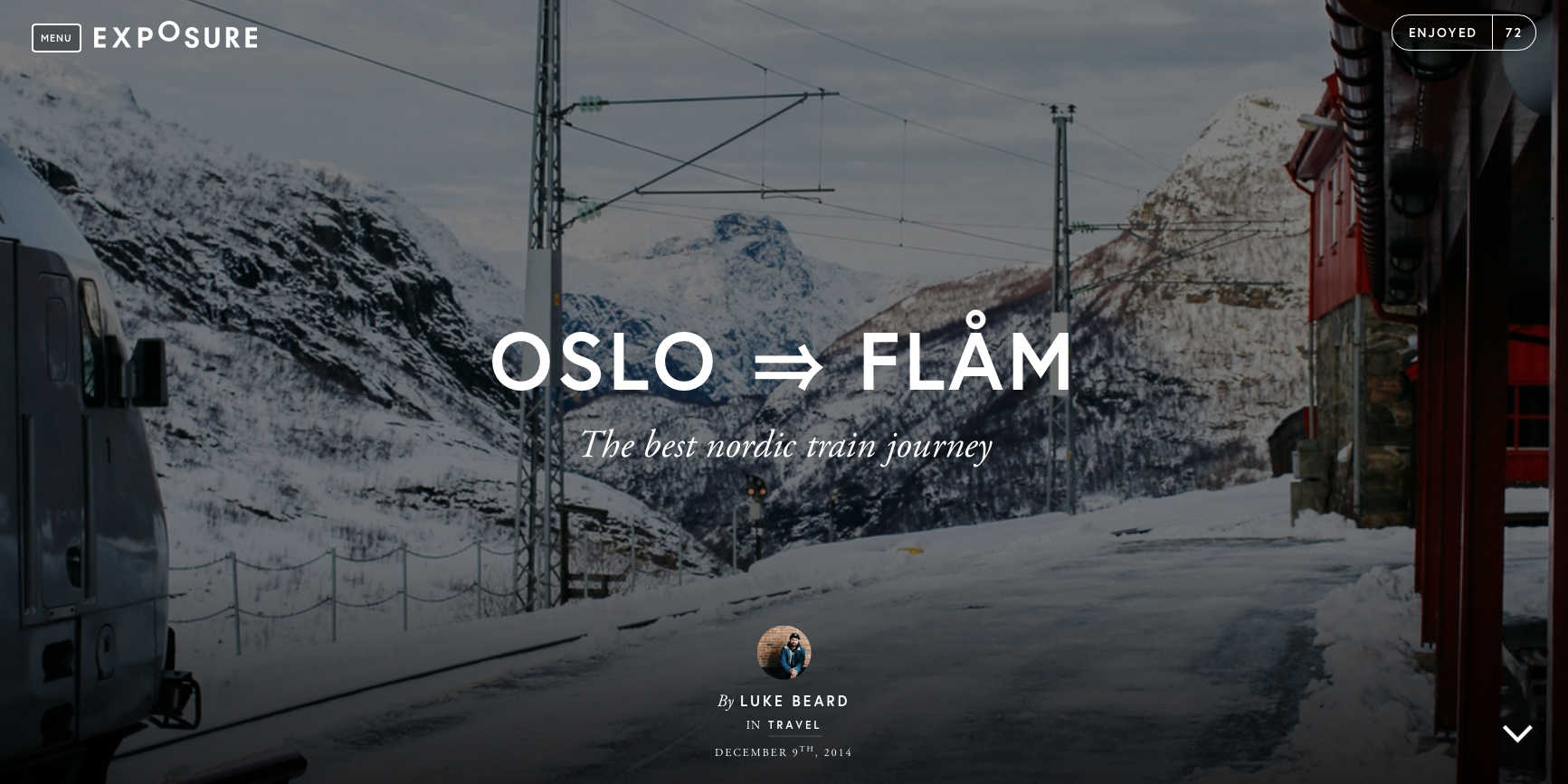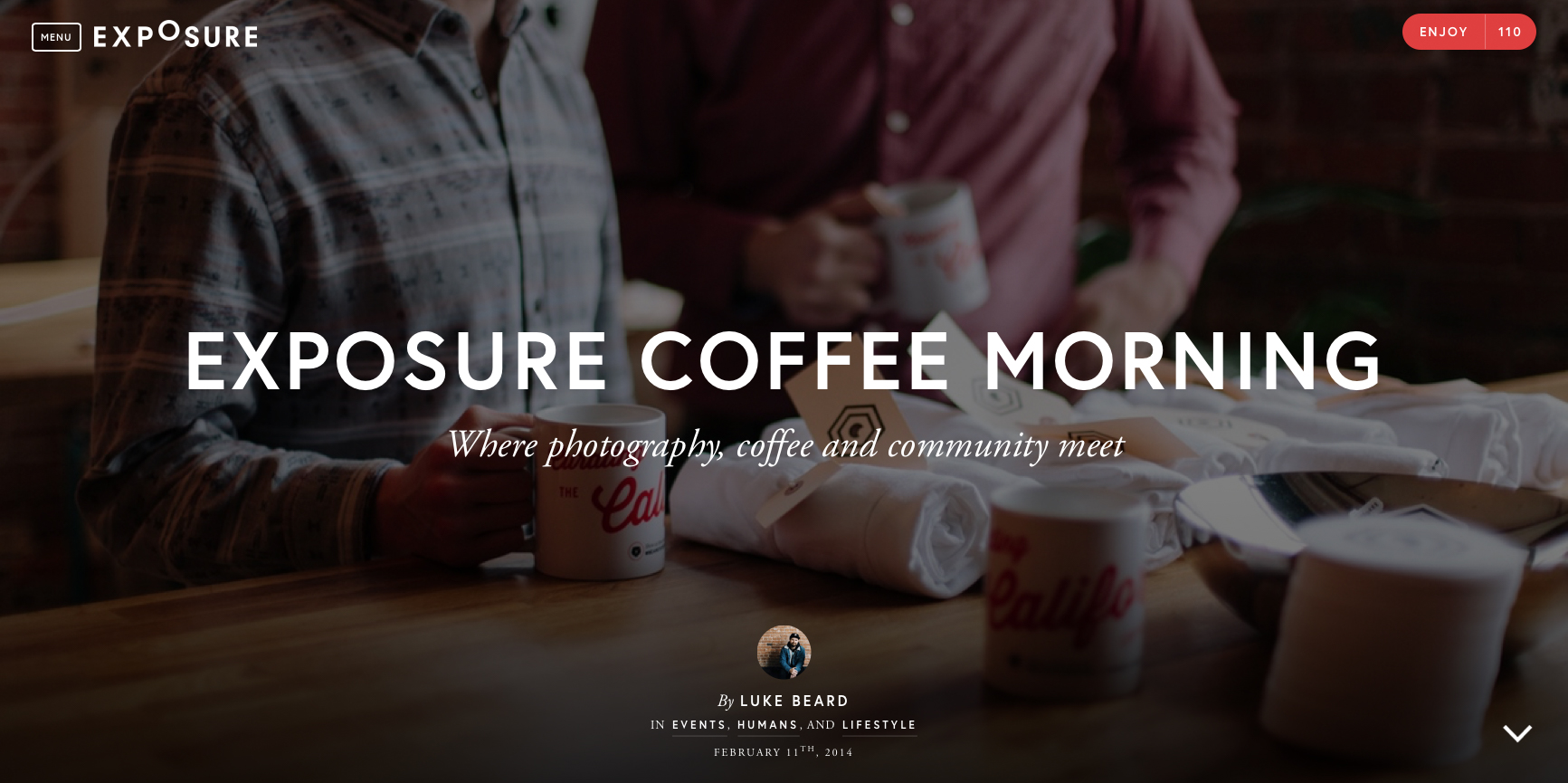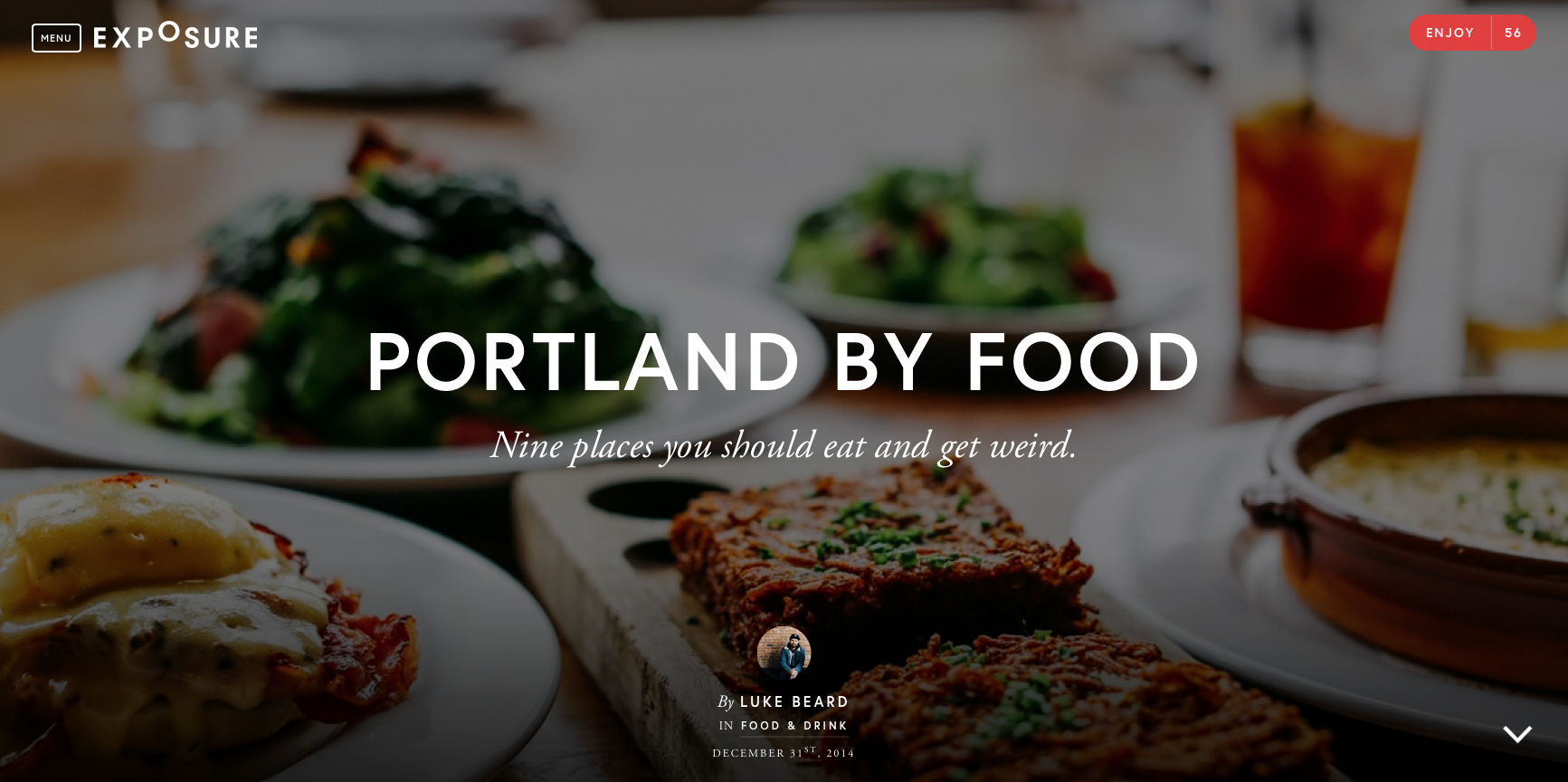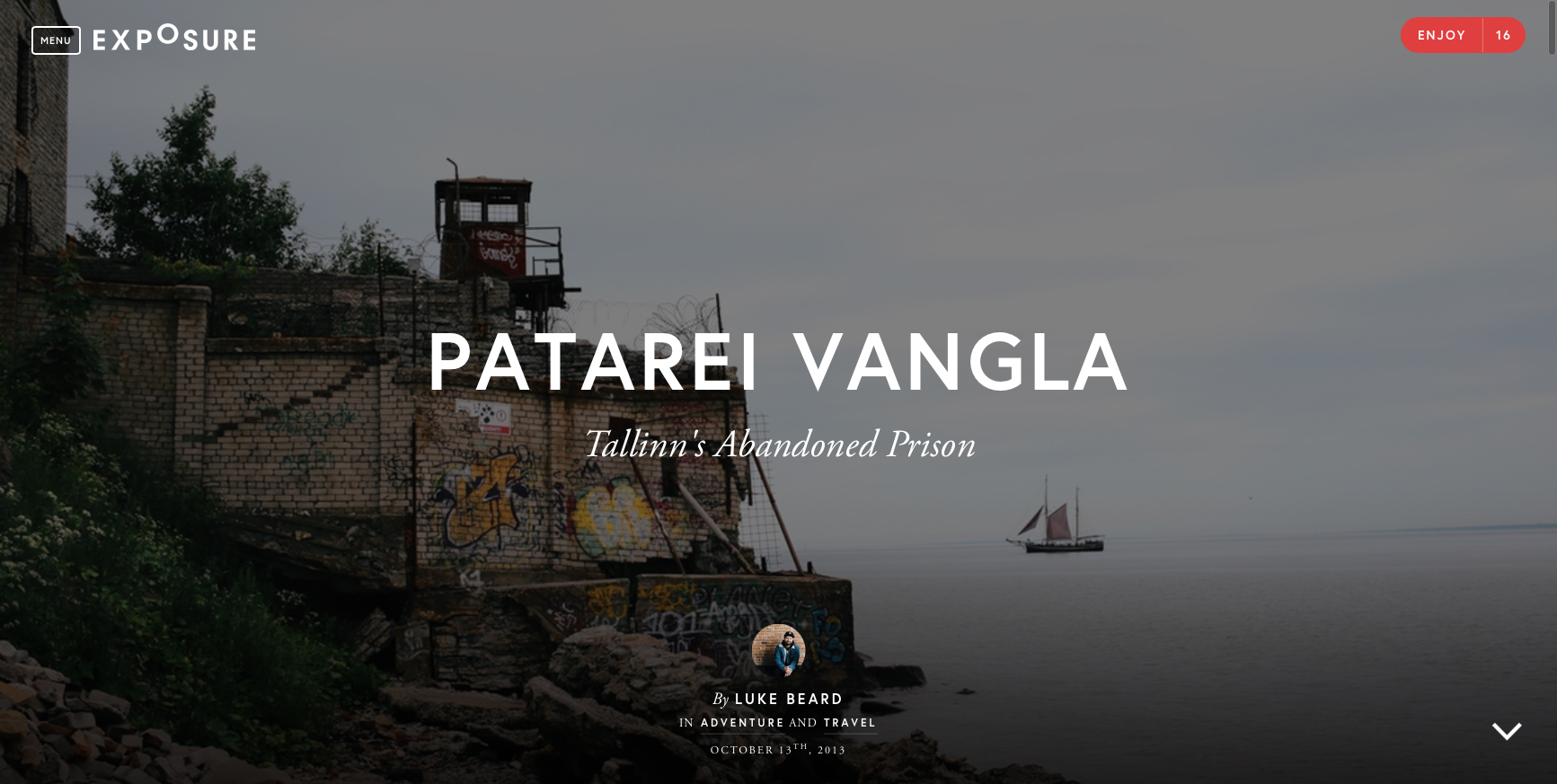Building your own ideas is high on most of our lists, but rarely do many of us take them on and evolve them into something useful or with longevity. When matched with a problem, Luke Beard took a hobby, paired it with his risky travel plans and a new mindset of creative work colleges, and created what I would class as one of the purest platforms for storytellers to use, Exposure.co.
As simple as putting pen to paper, they have created a platform where anyone can showcase photos with narrative text and create a sleek story with no hassle other then a simple drag and drop – free to share and stand with other great tales from around the world.
Not only is the business he created interesting, so is his journey, from leaving the UK to living in San Francisco and the company he works within. I imagine most of you will have the same first reaction I did, which was, “How do I get a job with you guys?”
START
BOYCE: Where does it all start?
LUKE: The weird thing is, I was never creative as a kid really, and I mean I did doodling, that was as far as my creativity went. I was never super into anything like that – it wasn’t in my vocabulary till I went to college.
I had a teacher there called Ray, who was always raving on about technology design. He wasn’t really super stoked on anything but design, and we always ended up doing Photoshop stuff because he loved it. So this was the first time I got to play with web design, html, and CSS.
I produced something that felt legit [and] it just made sense to me. I could understand the software and can make it do what I wanted. That was my first step; I was 18.
Instead of going to University, I started self-teaching at home on these skills and just playing around with a few tutorials here and there, but the main thing I was into was reverse engineering.
It got to a point where I didn’t know how to move my work forward. I knew I needed to go into a studio or something, and it was actually a government plan that helped me; a sort of job seekers programme. I went in and asked for help and they placed me in this design studio. I started off on a trail, ended up with a full time design job. I felt like I had made it!
“IT TOOK ME A LONG TIME TO FIGURE IT OUT [THAT] IN THE RAWEST FORM, I WANT TO BUILD GOOD THINGS.”
I learnt a lot there – people skills, what non-creative people expect – and I also got to build a lot there, too. So I learnt the base of my front end skills there and 3 years went by. It was cool but I got restless, started looking elsewhere, trying to figure out what to do next.
Then I remember one afternoon I was bored and just wandering the Internet and made some dumb tweet, saying something like I would really like to work on a project in America. I was dabbling on this service called Zerply at the time – I had been chatting to the creators a little bit online too and they saw this tweet and were like, “Come to Silicon Valley.” I was super naive, didn’t know what that meant, Googled it, and was like, “Wow, this is the dream.” I remember calling my mum and dad, being like, “Does this sound like a good idea? Because I would have to quit my job.”
I bounced. I was nervous as hell on my way over, got to Mountain View, California, and we pretty much hung out making stuff for five weeks. At the end, they asked if I wanted to be their designer, so that was wild. I had no idea what I was doing, I didn’t know how much they were paying me, I just wanted to do this, so I was like fuck it, I want to make product. I built my first real product for a year straight with them, remotely mostly from the UK. A year later, we had built a lot but it was time to move on. The work I was doing was spreading through the right channels. It had given me a bit of credit to my name at that point. I was getting emails from Google and Facebook and was like, “Guys I’ve got to go.” I’m still friends with them and I really appreciate the opportunity.
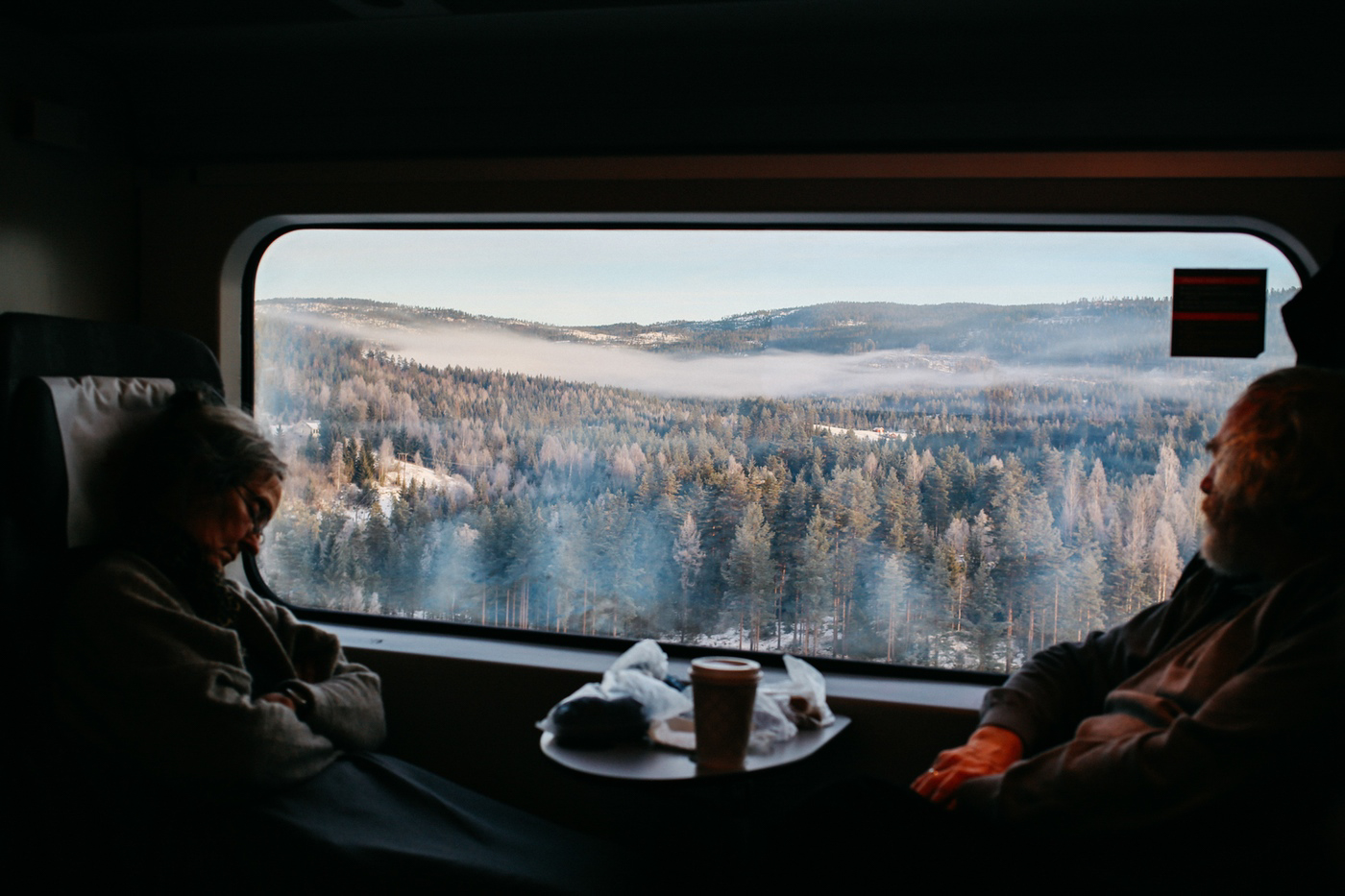
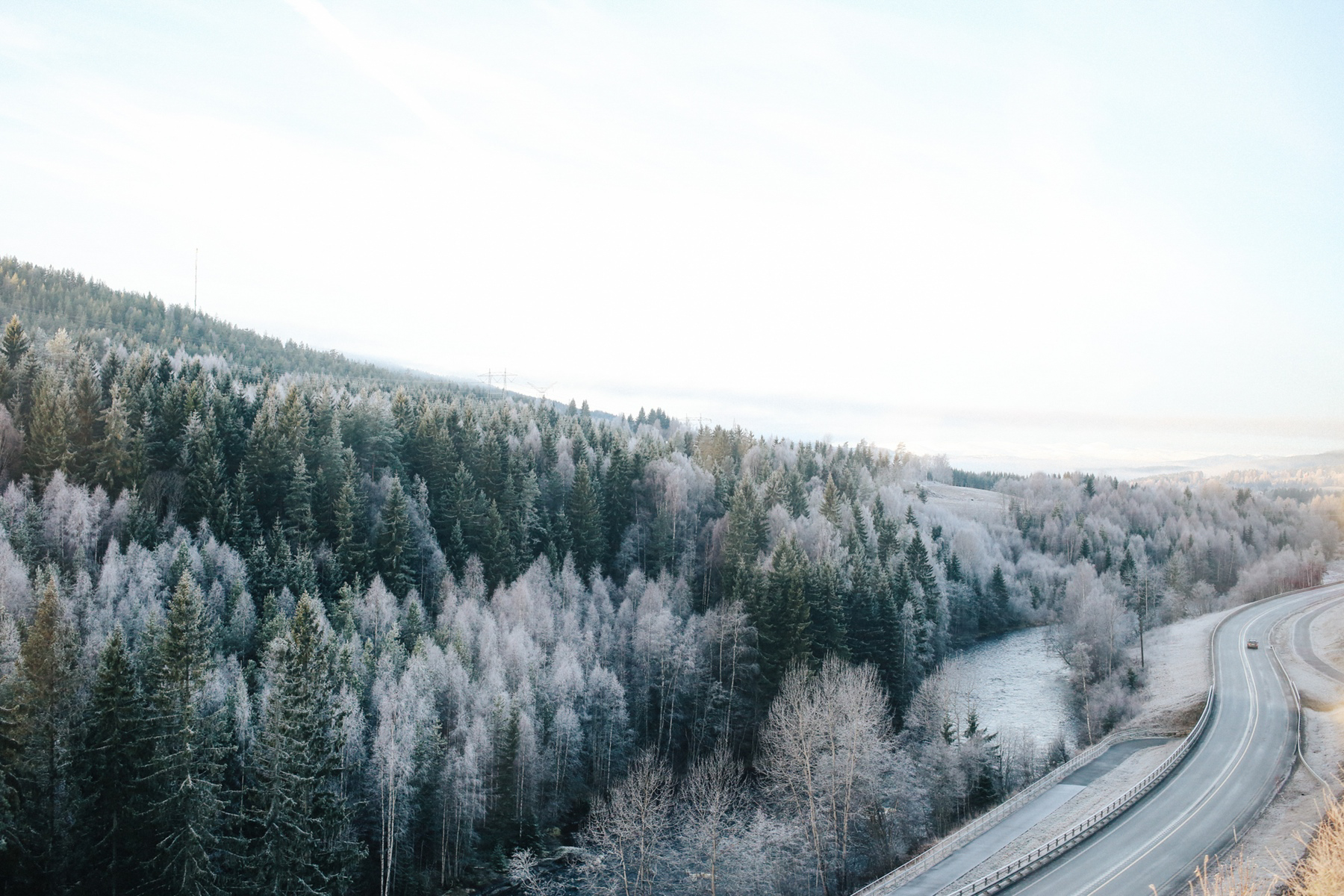
THE MIDDLE
This is when you made the jump then?
I did some consulting for a few years which worked really well for me. My main long term client was Hipstamatic. It was really fun, but there was something about belonging to a team that I wanted. I also knew if I wanted to do this for a career, I needed to be in the right surroundings, in San Francisco, so I packed a suitcase full of stuff and headed off.
At that point, I met Kyle Bragger. We had been Internet bros for a long time and we started hanging out. He kept inviting me over to Elepath for lunches, some which turned into ambush interviews. He was sending me doodles of me jumping on a Elepath logo, etc.
So I was like, “Fuck it.” My mentality is I love building stuff, and I love building stuff as a team, but I’m also a designer, so I’m restless. I like doing different things. Elepath is a place where you’re given all the resources to be creative and do stuff with meaning. We are solving our own problems and building stuff that we know isn’t shit. Because it’s easy to get tunnel vision on a project, being like one more chance, one more thing, Elepath isn’t that mentality, it’s like, “This failed. Next.” It was really attractive, because it was the perfect set up. They were like, “We will get you your visa and set you up. Here’s your salary,” and I was like, “Fuck yeah.” That was it, really. I spoke to Jake Lodwick [Elepath’s founder] a good few times, chilling by the ocean, really openly talking. Like ethos – very much like what I want to do with my career.
What was the answer?
It took me a long time to figure it out, in the rawest form I want to build good things that happen to be business. Like if there’s anything I have learnt from being in this start up circus, unless your user graph is up to the right at a 90% angle, you’re going to fail. Investors invest in a lot of stuff because a lot of stuff fails. So to build a tasteful piece of software and know its sustainability, that was something I wanted. I don’t want to build free or flip software, I want to build a sustainable business. It just happens when you find the right people that believe in that – like all the guys at Elepath – you can really do that and have a career from it. So that is where I am at now.
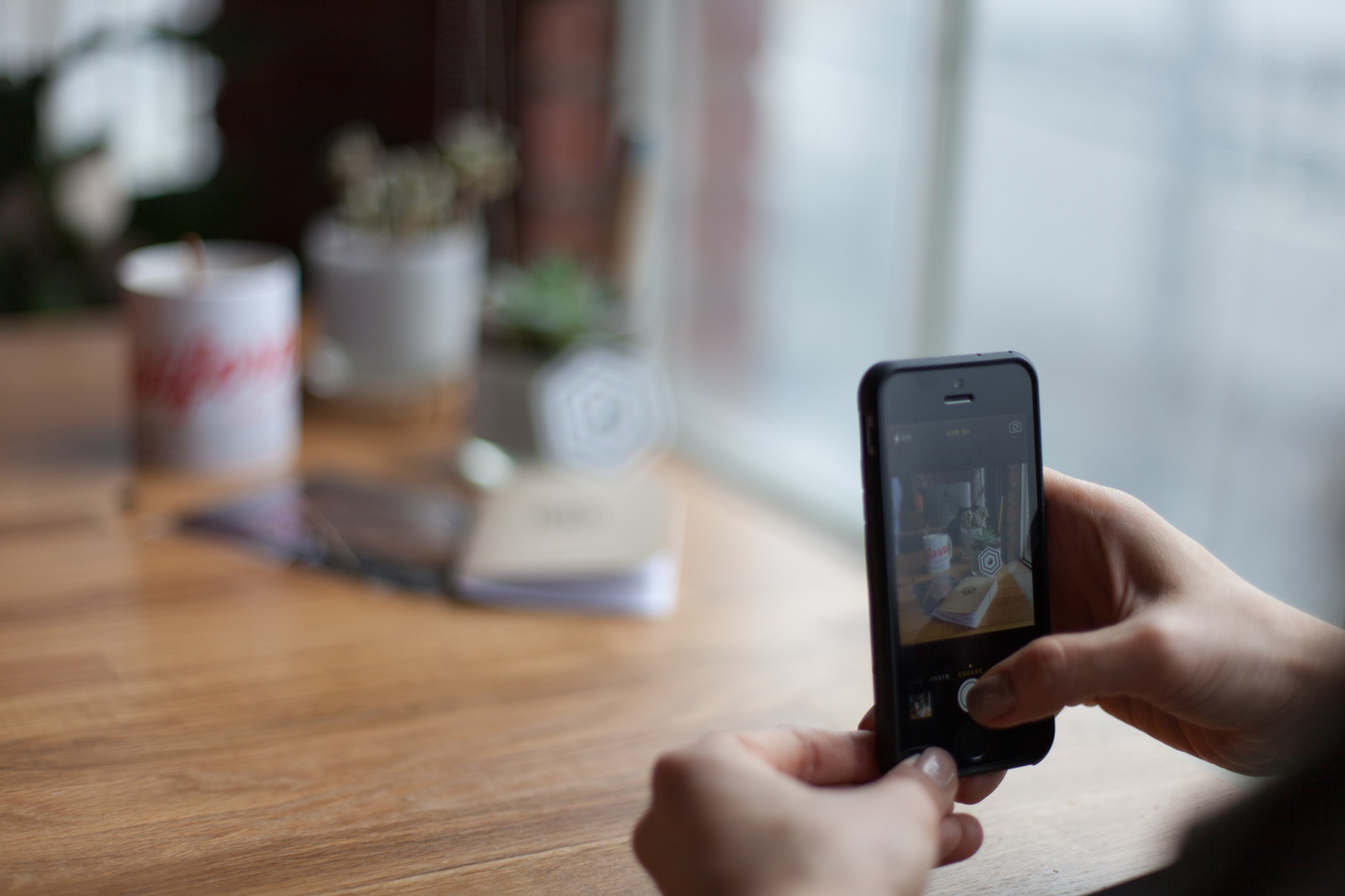
THE END
Tell us more about Elepath, what’s the mindset behind it?
Jake’s vision with Elepath was to build the perfect environment for creative developers, engineers and designers; people that develop ideas. He gave us everything– the space, the equipment, the salary, the insurance, resources – and Elepath evolved in a support layer to build amazing product on, which is still what they do today and what they want to continue to do. It’s full on faith, and commitment in me, which is amazing. It’s all worked out pretty amazing, I’m very blessed to keep doing this.
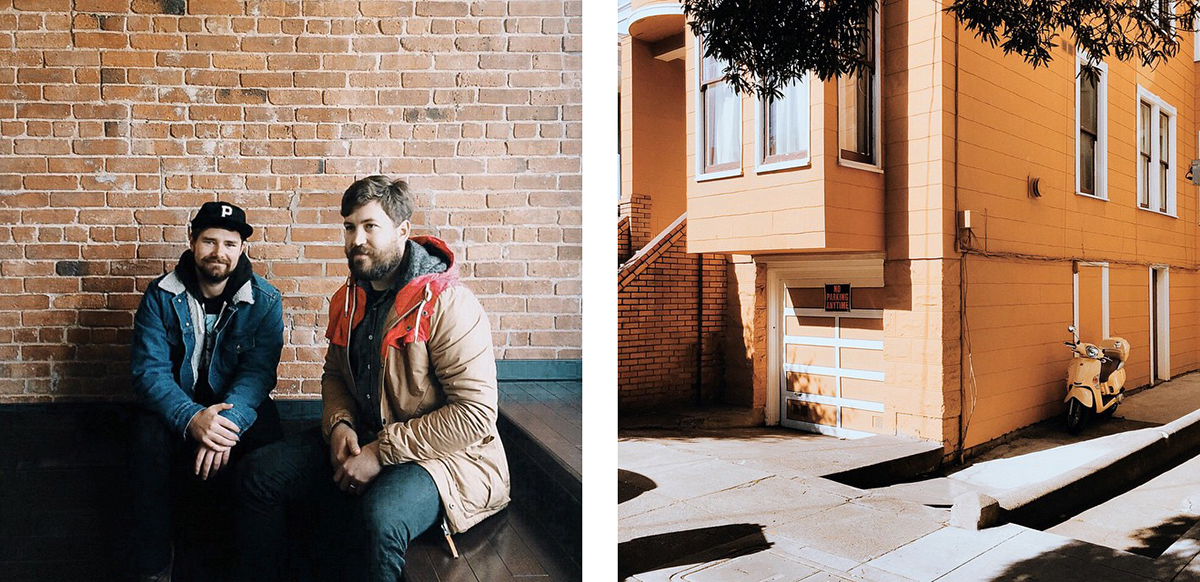
So, Exposure.co, where did the idea come from?
I had a little time at home while waiting for my visa to be fixed, so I went to visit Estonia and I was actually given a Canon Mark III as a joining gift from Elepath. [It] was my first real trip with it. We went to this gnarly old Russian prison; it was the trippiest thing ever. I caught the whole trip with my camera.
So I came back and I did a bit of editing – I’m by no means professional, just a happy hobbyist. I edited them and then was like, “Where do I put these photos?” I had never come across this [problem] before, because I was so used to taking like one-shot stories. I didn’t want to put them on Instagram as these were huge photos – I wanted to do something cool with this. Tumblr didn’t seem right; I didn’t want my photos sitting next to an orange is the new black quote and a gif of a panda sneezing.
At the time, I was reading a lot of photo-focused quarterly publications, and [I thought], “This is what I want to do with my photos.” I wanted to put these on the Internet but I didn’t want it surrounded by interface; I wanted be able to throw photos directly into the page and write straight alongside, add location and have a nice cover, and that’s it. I was chatting to Kyle through all this, because I was working on other Elepath stuff, looking for my idea, and he was like, “Put some designs together for this and we’ll figure it out.” I was like, “Oh shit! Yeah, that’s how this works now.”
“[EXPOSURE.CO] IS A VERY HONEST PRODUCT.”
So I put some stuff together and stumbled upon what we pretty much [have] now. Kyle’s such a good engineer. In a couple of weeks we had that prototype going and it felt real good. Elepath has a process differentiation where you have the sketch (the prototype), the beta – which was giving it to people seeing if they like it, and if that was a success, put it in to business. And that’s exactly how it went. We gave it to 200 people and they loved it. We asked if they would pay for it and the answers were, “Fuck yeah.” We talked it over at Elepath to see how everyone felt about it and everyone agreed it’s great, so we fixed it up ready to launch.
It is a very honest product. It was kind of barebones at the start. People would ask us why we don’t have this and that, because we wanted just the essentials you need. We were a very focused product. December 6th 2014, we released it to the world, and nearly a year later people are still paying to use it and we are on track to become profitable in a short amount of time, which is incredible.
Exposure is my first product; the first I have worked end-to-end on my own idea and produce. We have plans for the future, and I think Exposure could be a bigger force in photography to help everybody. We are trying to make it easy for photographers to make money and become prosperous from what they do at any level. Can’t talk about all of it, but there’s a bunch of cool shit coming and I’m very excited that it’s very lean as fuck.
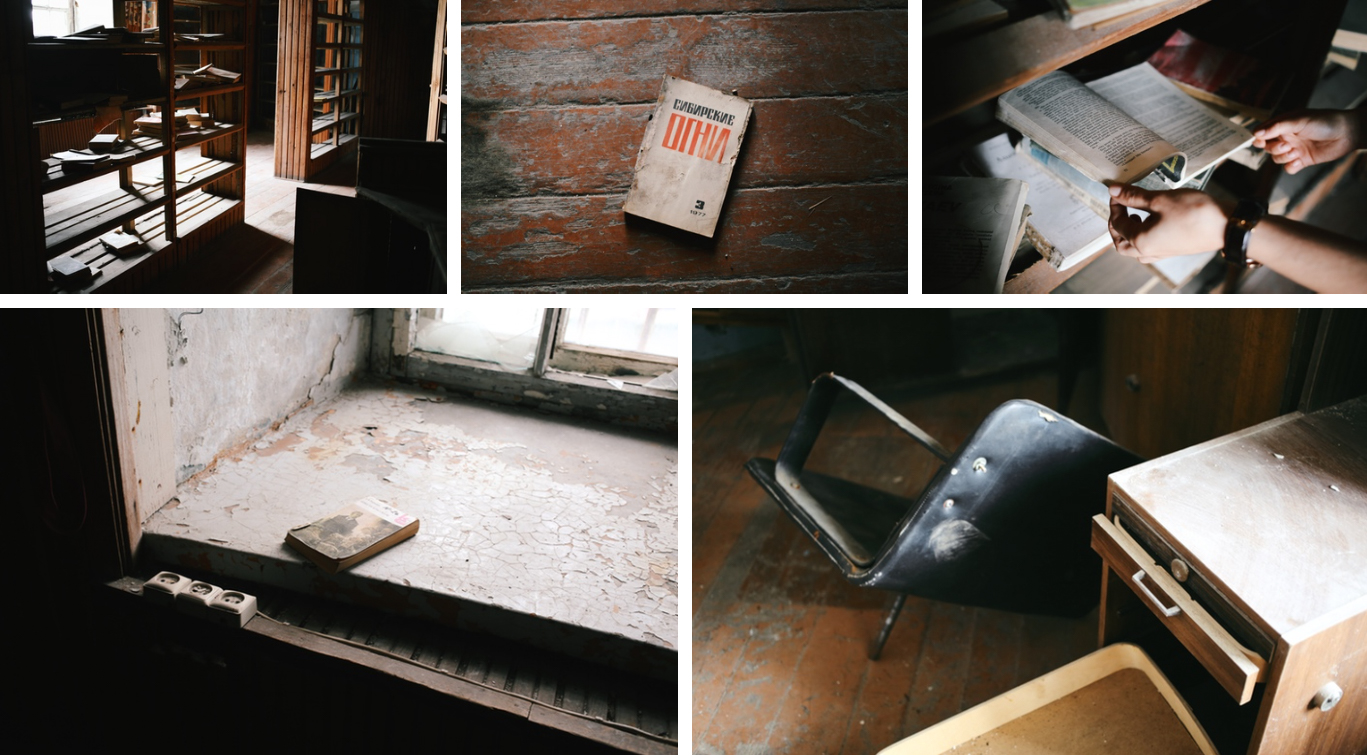
::
I have talked about this before. Along your life you meet certain people who enrich your options, pushing you to take that big leap, whether that be with supporting you, presenting you with that opportunity or just opening your mind to the idea. Learn your craft, put yourself out there to learn more, and that normally leads to opportunity.
“The meeting of two personalities is like the contact of two chemical substances: if there is any reaction, both are transformed. ” -Carl Jung
This story of Luke, jumping boat to do what he truly enjoys and learning along the way, shows that when working at something you truly adore – matched with your own risk taking and real social interaction with people via anyway you can – it can give you some amazing opportunities in your life and present you with that product, business, or career you couldn’t before quite put your finger on.
Thanks again for taking the time to chat, Luke.
You can follow Luke via his Exposure, Instagram, Twitter ,or hit him up for advice at yo@luke.so.
Toodle Pip,
Boyce

